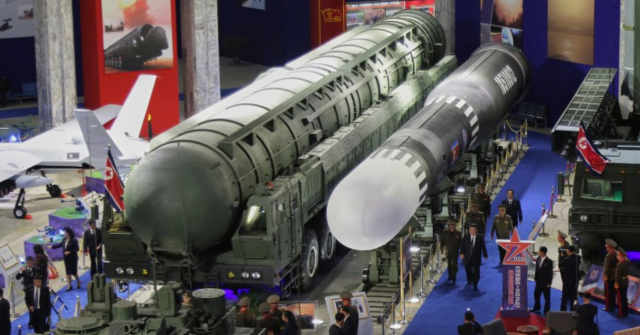North Korean dictator Kim Jong-un held a massive military parade on Friday and Saturday in Pyongyang that included the public debut of North Korea’s most advanced intercontinental ballistic missile (ICBM), the Hwasong-20.
The Hwasong-20 is not quite ready for testing yet, much less deployment, but if its capabilities live up to Pyongyang’s boasts, the gigantic multi-stage missile could reach any point in the continental United States, and it could carry multiple nuclear warheads.
North Korean state media hailed the Hwasong-20 as the “most powerful nuclear strategic weapon system” in Kim’s arsenal.
“The Hwasong-20 represents, for the moment, the apotheosis of North Korea’s ambitions for long-range nuclear delivery capabilities. We should expect to see the system tested before the end of this year,” analyst Ankit Panda of the Carnegie Endowment for International Peace said on Saturday.
“Multiple warheads will increase stresses on existing U.S. missile defense systems and augment what Kim sees as necessary to achieve meaningful deterrence effects against Washington,” Panda added.
The actual threat posed by the Hwasong-20 is difficult to judge because North Korea has yet to develop re-entry shielding that could allow it to equip an ICBM with a nuclear warhead and its guidance technology for long-range missiles has been unreliable.
South Korean defense analysts said they could not be certain if a prototype Hwasong-20 missile was actually present at the parade, or if the audience merely saw its transport and launcher. South Korean intelligence suggests the Hwasong-20 could have 40 percent more engine power than the previous missile in the series, which would give it longer range and a heavier destructive payload.
The parade also included eight Hwasong-11Ma missiles, which are supposedly hypersonic short-range ballistic missiles. Hypersonic missiles are significantly more difficult to intercept than slower weapons, although their performance in the Russia-Ukraine conflict has not lived up to their billing as unstoppable super-weapons.
The Pyongyang parade also saw the public debut of a few other weapons systems, including the Chonma-20 tank — supposedly competitive with South Korea’s popular K2 “Black Panther” fourth-generation main battle tank — and a multiple rocket launcher similar to the U.S. HIMARS system. As with the Hwasong-20 missile, the actual capabilities of these impressive-looking systems are still a matter of conjecture.
Kim’s military parade was part of North Korea’s 80th anniversary celebration for the founding of its ruling Workers’ Party. Several foreign representatives were in attendance, including Chinese Premier Li Qiang, Vietnamese Communist Party head To Lam, and Dmitry Medvedev, deputy chair of the Russian Security Council and former president of Russia.
Medvedev, who is among the most reliably belligerent of Russian politicians, met with Kim on Friday to talk about developing the “comprehensive strategic partnership and alliance” between Russia and North Korea.
Medvedev also praised the “bravery and self-sacrificing spirit” of the cannon fodder troops Kim dispatched to help Russia recapture its Kursk region from Ukraine. A unit carrying both North Korean and Russian flags marched in the parade, evidently intended to represent the soldiers Kim sent to Russia.
“We are grateful to the Democratic People’s Republic of Korea for its steadfast support of the special military operation. Our soldiers stood shoulder to shoulder to liberate the Kursk region. This feat will forever remain in our hearts,” Medvedev said on Russian social media after the parade.
Read the full article here
